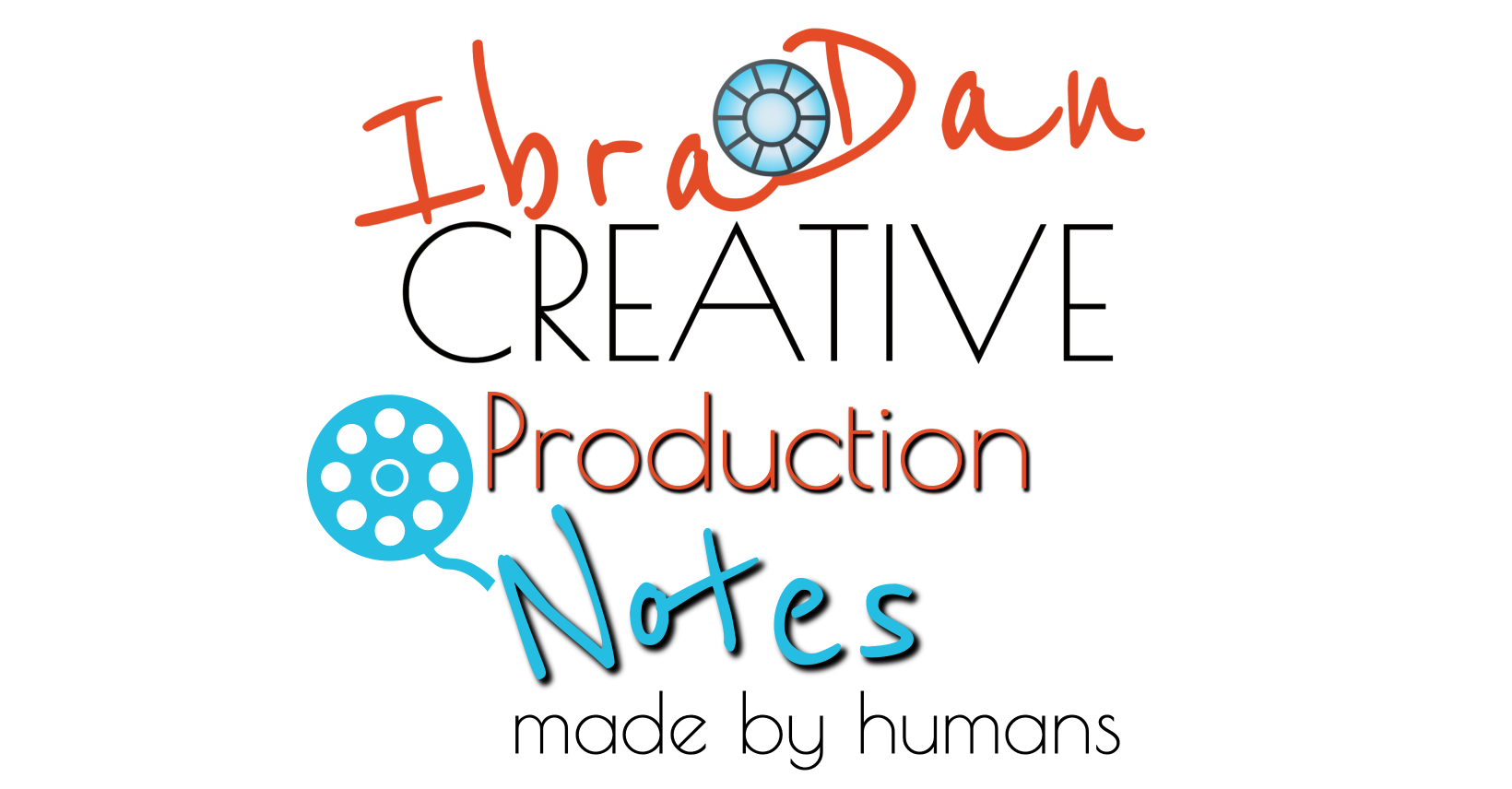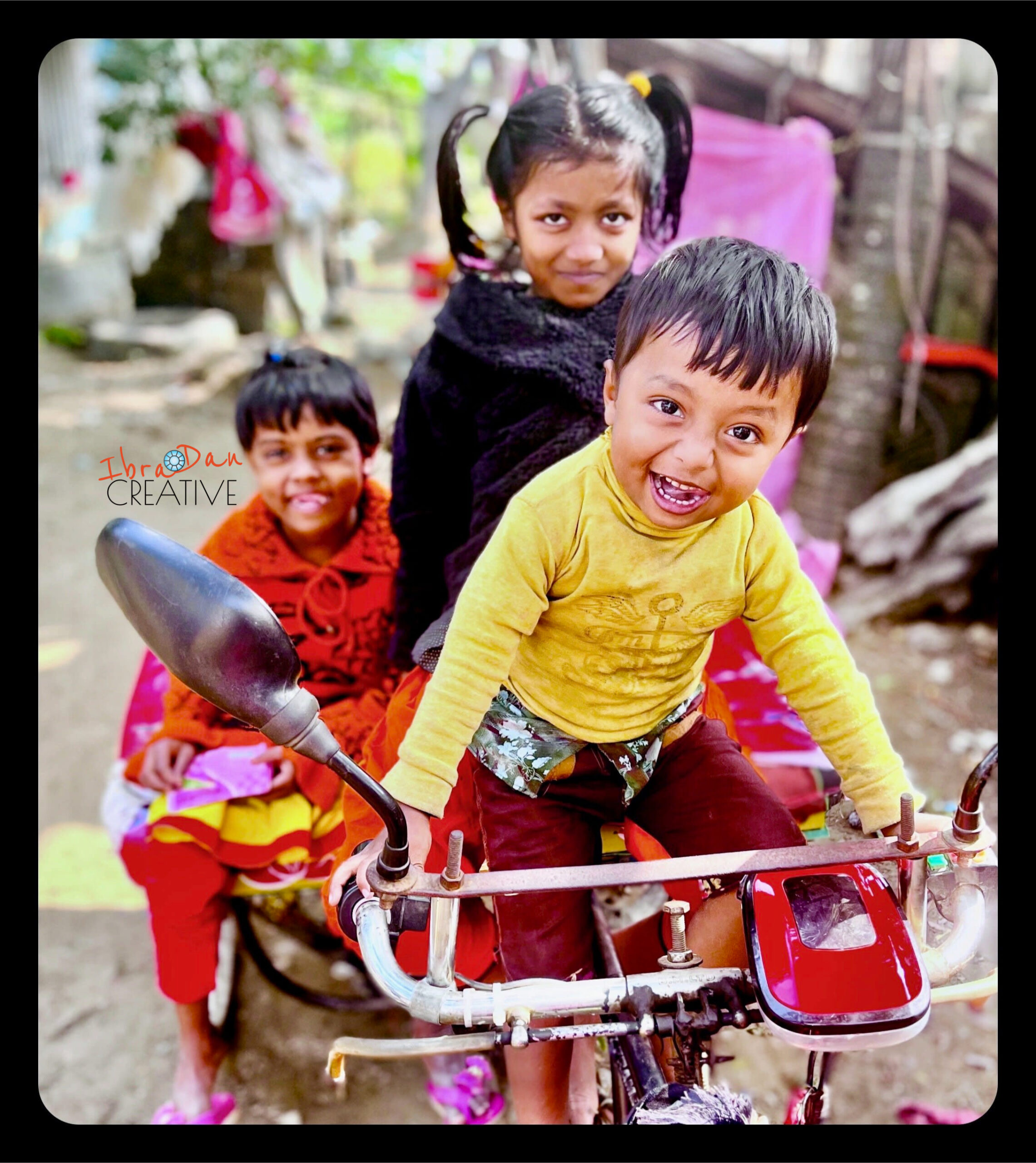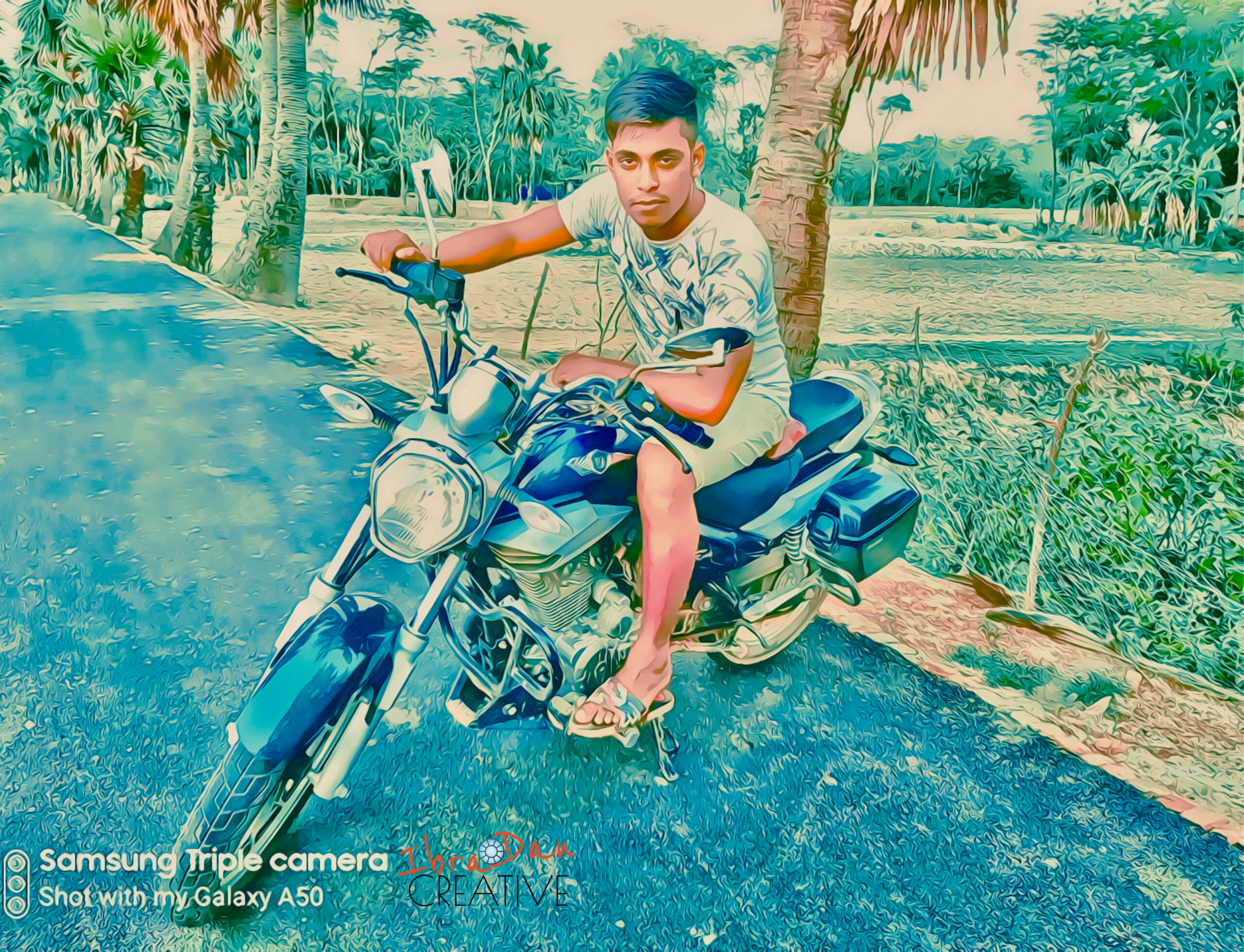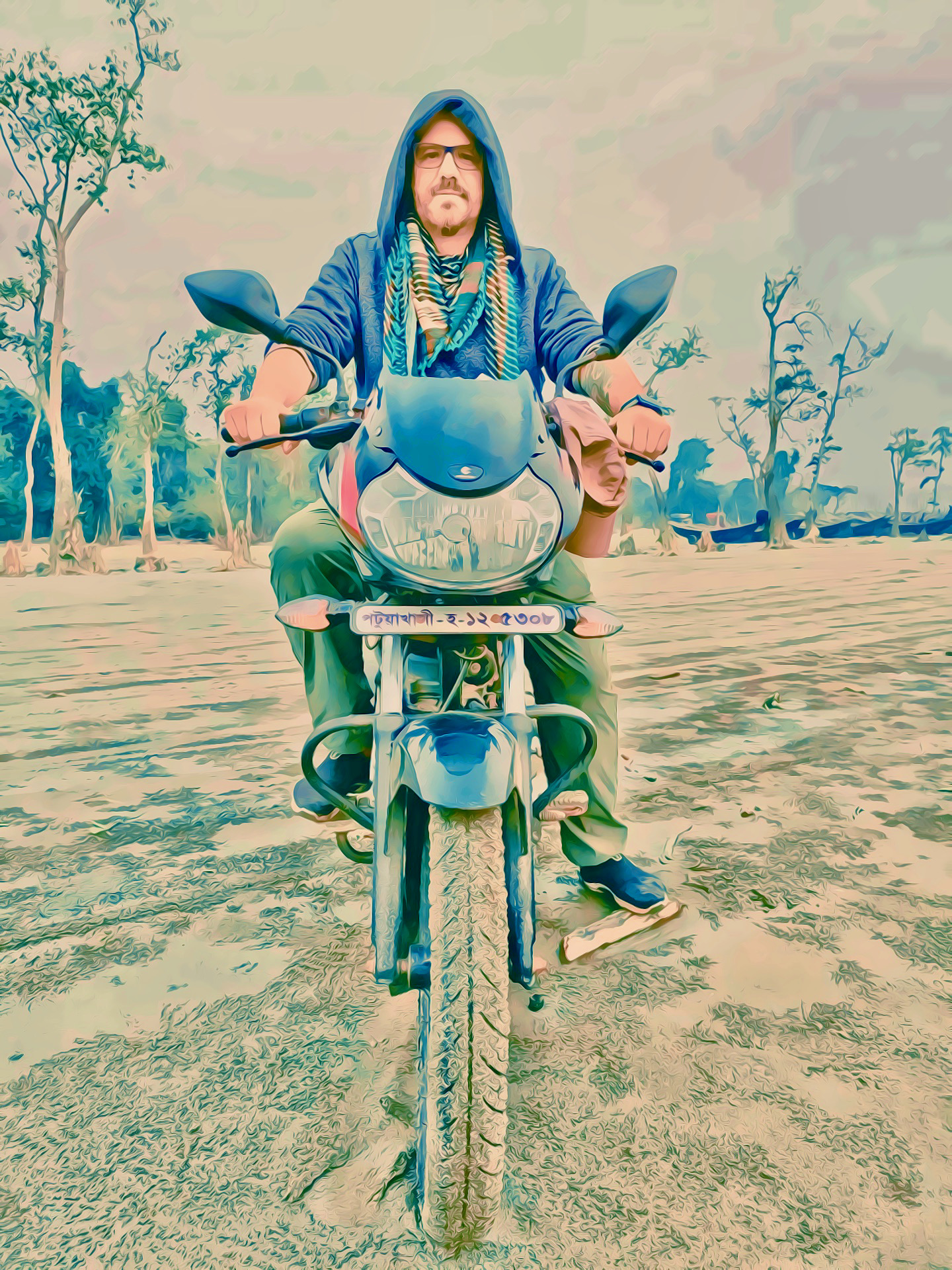Daniel-Ibrahim Tuk Tuk, Rickshaw, and Motorcycle Rides in Bangladesh
Even if I overpay for my ride by Bangladesh standards, as a tourist, I still get a great deal compared to more expensive North American fares.
However, don’t be a weenie and haggle over $1.00 — Pay the buck and give the guy a great tip.
Being a Bangladesh native, Ibrahim had a system for securing the best transportation fare.
As we approached the cluster of drivers mulling about the roadside, I would step back and tuck into a shop out of sight. Ibrahim would bargain in Bangala, and once he got the best price, he’d signal me to dash on board. –worked like a charm.
By default, as a pasty white tourist, anything I’d buy on my own was way more expensive than what locals pay. I don’t blame them; they know I can afford a premium. And honestly, they deserve the extra cash.
Nevertheless, technically speaking, Ibrahim is the paying native customer, and any money saved as a couple went directly to helping family and friends with groceries and other goodies.
Incidentally, we did the same haggling for just about everything we purchased. I’d scope out a garment in a shop and walk away seemingly uninterested, and then Ibrahim would return and make the purchase.
Once, he was bargaining with a farmer for a plump goose. He did well until I decided to film the negotiation on my iPhone. Suddenly, the price doubled for the bird. Unfortunately, the locals in his village were onto us, and mysteriously, shopping got more expensive unless he shopped solo as I blended into the adjacent background (yeah, right).
Tuk Tuks
In Bangladesh, Tuk Tuks are tiny, green, three-wheeled cages with a single driver seat in the front and a wide-ish back seat with just enough room to cozy up and violate a Western tourist’s need for personal space.
One exception is if you aim to inappropriately fondle your new-found friend’s thigh — but that’s another matter (perv). I sat next to Ibrahim, so holding hands and whispering in each other’s ear was always a treat. There is nothing like hiding a relationship in plain sight – eh!
If you are lucky, there’s another two-seater facing you with just enough room to play footsie and rub knees with a hitchhiker; Not so lucky if one of them loves garlic or just finished a 14-hour shift at the fish market and sneezes in your face then tries to hork a green alien from his throat through the 1×1 inch wire grid — on YOUR side of the windy cage. — but I digress.
If you have dentures, hang onto them because there’s a reason you’re locked into a welded cage with steel-reinforced wrap-around bumpers. Do you remember riding bumper cars at the amusement park when you were a punk ramming into the smallest kid on the track?
N95 masks are highly recommended because just when you get trapped in an illogical traffic jam, an apocalyptic-looking bus that seems like it rolled off a cliff will stop three feet from your face and power blow a black plume of toxic carbon dioxide directly into your face and fill the cockpit of your tuk-tuk coffin making you want to vomit everywhere.
Oh, and remember earplugs because everyone honks at everything all the time, everywhere! The endless stream of honking monster busses whiz by your ear with little more than 6 inches of space between their meat-grinding frames and your arm.
Yeah, forget glass windows and enjoy the torrential downpour or blazing humidity. As a Westerner, don’t freak out when a tiny boy tries to sell you a road-kill sandwich at a stop in the middle of the road or an elderly woman begs you to help feed her emancipated child.
The disfigured men dressed in rags chanting Allah Aukbar and sticking their fingers through our cage got me every time. Ibrahim prefers to donate to the Transgendered souls that work in pairs and attack your bumper car from both sides; they’re aggressive and can outstare a billygoat. — hey, just like the drag queens in Toronto bars.
Sometimes, it takes about an hour to get a few miles down the way, but don’t worry, you can get across town for peanuts. — who said modern slavery was abolished, but then what choice do these kind-hearted people have. Some have multiple wives and tiny mouths to feed. So pay double the fare in tips, and don’t be a cheap tourist, or mother karma will bite you when you return home.
Oh yeah, I forgot about the bladder issue.
Stay home if you have the trots or eat local food the day before. Wear a diaper if your prostate is acting up or you feel the urge to tinkle every time you swallow. I gave up being ashamed to carry my own roll of ass wipe under my armpit or asking the driver to pull over so I could expose myself along the medium to pinch an emergency loaf — everyone else does it!
If you are crafty, you’ll wear a lungi and pretend to be changing a tire — but know you ain’t fooling anyone. The locals are masters at giving birth to an alien in public.
And finally, if you’ve arrived in Bangladesh with two large check-in bags, take a four-wheeled Uber or turn back unless you’re Harry Houdini and can contort yourself on or into local modes of transportation.
Wikipedia says…..
Auto rickshaws (locally called “baby taxis” and more recently “CNGs” due to their fuel source, compressed natural gas) are one of the more popular modes of transport in Bangladesh, mainly due to their size and speed. They are best suited to narrow, crowded streets and are thus the principal means of covering longer distances within urban areas. [23]
Two-stroke engines have been identified as one of Dhaka’s leading sources of air pollution. Thus, since January 2003, traditional auto rickshaws were banned from the capital; only the new natural gas-powered models (CNG) were permitted to operate within the city limits. All CNGs are painted green to signify that the vehicles are eco-friendly and that each one has a meter built-in. [24]
Or Take a Cycle Rickshaw.
Cycle rickshaws are human-powered by pedalling.
Seeing these thin, weathered, stress-faced guys peddling Ibrahim and me weaving through a cacophony of fast-moving obstacles on rough roads, sometimes against traffic, freaked me out.
I felt somewhat ashamed getting about town via the oppressive manual labour of some poor, suffering soul with no other option for survival.
I felt guilty watching them toil under extreme rain, heat, wind, etc. I wouldn’t last a day doing that kind of harsh manual labour. — Sometimes, I wanted to cry, empathizing with the hardships compared to mine. Why them and not me, Allah?
Alhamdulillah, for my privileged lifestyle. Ibrahim and I always made sure we tipped well. I doubt most of my friends and family fully grasp how blessed they are to live in such an abundant, developed country like Canada!
Approximately 400,000 cycle rickshaws run daily. [18] Cycle rickshaws in Bangladesh are also more convenient than the other public modes of transport in the country, namely auto rickshaws, cabs and buses. They are primarily convertible, decorated,[19] rickshaws with folding hoods and are the only kind of vehicles that can be driven in many city neighbourhoods with narrow streets and lanes.
However, increasing traffic congestion and collisions have led to the banning of rickshaws on many major roads in the city. Urban employment in Bangladesh also largely depends on cycle rickshaws. Because of inflation and unemployment in the rural areas, people from villages crowd into the cities to become rickshaw drivers, locally called the riksha-wala (রিকশাওয়ালা)
Get Around By Motorcycle.
Another standard transportation mode is hiring a 150 cc motorcycle – They’re everywhere.
It’s challenging to fit three big guys or a family of three or more on one bike. Women saddle sideways with kids on their laps. Often, their Burkas are dangling in the wind and inches away from getting caught in the rear tire and ripping their scalps off (it’s happened).
What an immersive way to live, love, and learn.
You grope the driver from behind with your crotch and wrap your arms around his tiny waist, then the person behind you does the same thing. Travelling with Ibrahim is fun! Transporting a live goat, luggage, and market supplies on a tuk-tuk or motorcycle takes practice. Keep your mouth closed, or you’ll swallow flying things.
Eventually, I got the hang of balancing and taking video selfies of our rides. Ibrahim and I travelled to remote areas, captured exotic images, and practiced using our new drone gear in unique settings. Crashing into the odd tree, chasing animals and teasing the locals was particularly interesting.
It’s a funky feeling when your butt cheeks and crotch go numb and tingle a thousand needles after a long trip.
If I had to earn a living transporting people, I’d pick a motorcycle but stay off the main streets of Dhaka.
With love and respect
Daniel-Ibrahim
FYI
The primary reason for traffic jams? 70% registered vehicles in Dhaka are motorbikes, private cars.
Here’s a great excerpt from Worldbank.org’s blog
Source: WorldBank.org Blog Can We Build Dhaka out of Traffic Congestion?
Dhaka, the capital city of Bangladesh, has been dubbed “the traffic capital of the world” because of its chaotic traffic and frequent traffic jams. Some say Dhaka needs more roads because only 7% of the land is covered by roads in Dhaka, while in many developed capital cities, it is more than 20%.
Some numbers illustrate the real problems in Dhaka’s urban transport. Of the 21 million daily trips generated in the Dhaka metropolitan area, only 5% are carried out by private cars, which use roughly 80% of the road space and are the leading cause of traffic congestion.
Yet 28% of the trips are carried out by buses, which only use about 5 % of the road space. Additionally, 58% of the full trips are made by walking, bicycling, or riding on rickshaws, also called non-motorized transport modes (NMT).
But these NMT modes need more proper allocation of road space. There are no dedicated bicycle or rickshaw lanes on any roads in Dhaka. Less than 25% of roads have separated, paved sidewalks, most of which are either occupied by parked cars or damaged without proper maintenance.
NMT users have to fight with vehicles for their right of way on roads and thus expose their lives to huge risks. During my visit to Dhaka in April, a local newspaper reported that 12 people (including one family) had died in traffic accidents on one day; all were NMT users.
Here’s an excellent excerpt from Worldbank.org’s blog
Source: WorldBank.org Blog Can We Build Dhaka out of Traffic Congestion?
Dhaka’s traffic woes are a neverending source of frustration. There simply needs to be more roads to accommodate the sheer number of cars on the streets. Moreover, the traffic management system could improve, and more operational signals should be needed.
The absence of clearly marked lanes also adds to the road’s chaos. Additionally, streams of buses and countless rickshaws make it even more challenging to navigate through the streets.
Bangladesh is too poor to adequately address the imperative to build more modern roadways, flyovers, and elevated expressways. Traffic management systems need to be updated, updated, and fixed.
Let's KEEP in TOUCH
Daniel and Ibrahim’s candid, witty, inspired writing to explore ‘what-if’ storytelling on love, life, and creativity by a younger-older, eastern-western same-orientation couple often through an
Islamic Lens
LIVE, LOVE, and LEARN
Follow Daniel~Ibrahim (IbaDan Creative)
https://ibradan.com
https://www.facebook.com/ibradancreative
https://www.facebook.com/dan.trepanier
https://www.instagram.com/dantrepanier
https://www.youtube.com/@IbraDanCreative
https://medium.com/ibradan-creative
https://me.dm/@ibradancreative
https://ibradancreative.substack.com
https://www.linkedin.com/in/danieltrepanier
https://www.pinterest.ca/ibradancreative/_saved/
We have captured these 'Interesting Experiences" using an iPhone or drone throughout our travels.
Ibrahim is skilled at compiling clips, adding music, and using special effects to create short pieces for social media sharing.
On the other hand, I prefer to use Final Cut Pro but rarely find the time, so I post raw cuts instead.
Either way, enjoy these spontaneously taken videos.
Be inspired by the remarkable diversity Allah has created for us on planet Earth. Inshallah, you will capture and share your own stories.




